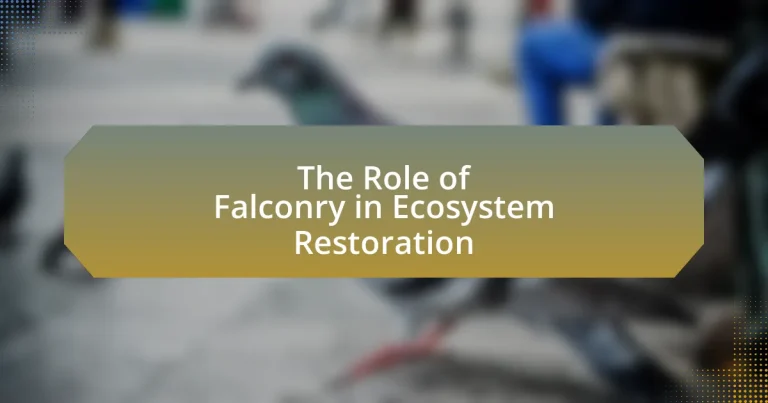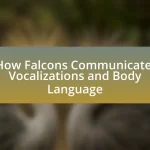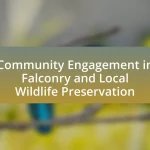Falconry is a practice that utilizes trained birds of prey to manage wildlife populations, playing a crucial role in ecosystem restoration. This article examines how falconry contributes to maintaining ecological balance by controlling overpopulated species, enhancing biodiversity, and promoting public awareness of wildlife conservation. It explores the specific ecological roles of falcons, the methods employed in falconry for habitat management, and the partnerships between falconers and conservation organizations. Additionally, the article addresses the challenges faced by falconry in restoration efforts and highlights the importance of education and innovation in maximizing its impact on ecosystem health.
What is the Role of Falconry in Ecosystem Restoration?
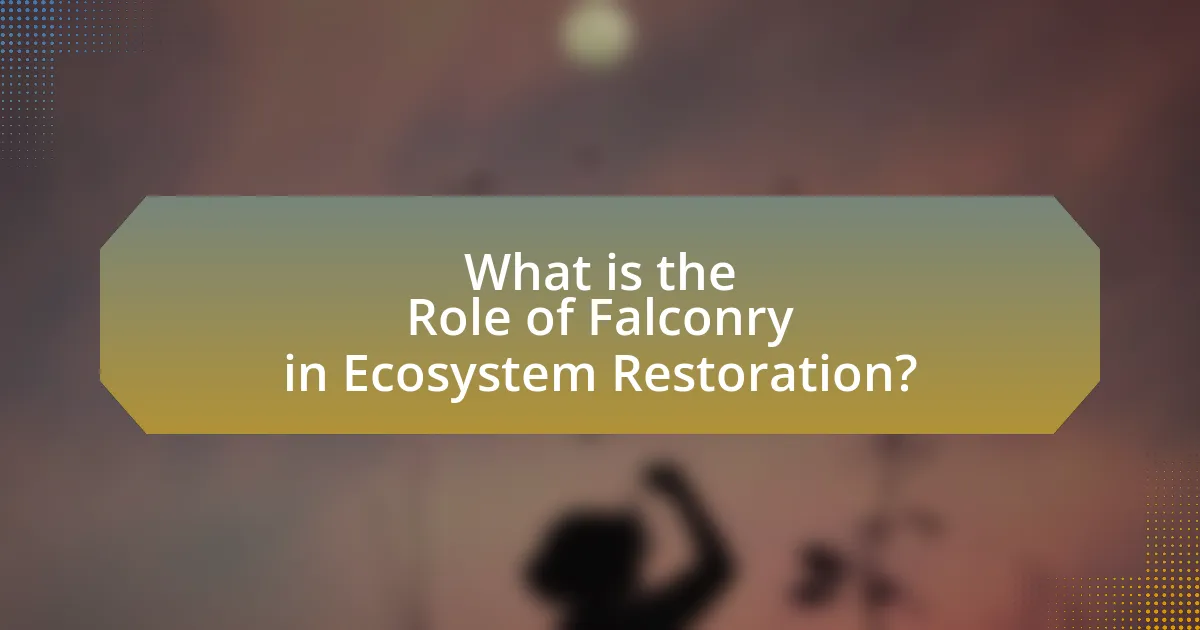
Falconry plays a significant role in ecosystem restoration by utilizing trained birds of prey to manage and control populations of certain species, particularly pests that threaten biodiversity. This practice helps maintain ecological balance by reducing overpopulation of specific species, which can lead to habitat degradation and loss of native flora and fauna. For instance, studies have shown that using falcons to control populations of invasive bird species can enhance the survival rates of native birds and promote healthier ecosystems. Additionally, falconry fosters public awareness and appreciation for wildlife conservation, encouraging community involvement in restoration efforts.
How does falconry contribute to ecosystem balance?
Falconry contributes to ecosystem balance by controlling prey populations, particularly small mammals and birds, which helps maintain biodiversity. The practice of using trained birds of prey to hunt can reduce overpopulation of certain species, preventing habitat degradation and promoting healthier ecosystems. For instance, studies have shown that raptors can significantly impact rodent populations, which, if left unchecked, can lead to crop damage and the spread of disease. By managing these populations, falconry supports the natural food web and enhances the overall stability of the ecosystem.
What specific ecological roles do falcons play?
Falcons play specific ecological roles as apex predators, contributing to the regulation of prey populations and maintaining ecosystem balance. By preying on small mammals and birds, falcons help control these populations, which can prevent overgrazing and promote biodiversity. Their hunting behaviors also influence the distribution and behavior of prey species, further shaping the ecological dynamics within their habitats. Studies have shown that the presence of falcons can lead to increased species diversity in areas where they are active, highlighting their importance in ecosystem health.
How does falconry influence prey populations?
Falconry influences prey populations by regulating their numbers through predation. The practice of falconry involves trained birds of prey hunting specific species, which can help maintain ecological balance by controlling overpopulated prey species. For instance, studies have shown that the hunting activities of falcons can reduce populations of small mammals and birds, thereby preventing habitat degradation and promoting biodiversity. This controlled predation can lead to healthier prey populations, as it encourages natural selection and reduces competition for resources among prey species.
Why is falconry considered a tool for conservation?
Falconry is considered a tool for conservation because it promotes the protection of raptor species and their habitats. By engaging in falconry, practitioners contribute to the conservation of biodiversity through breeding programs, habitat restoration, and public education about the importance of raptors in ecosystems. Studies have shown that falconry can enhance awareness and appreciation for wildlife, leading to increased support for conservation initiatives. For instance, falconers often participate in efforts to rehabilitate injured birds and release them back into the wild, directly aiding in the preservation of raptor populations.
What are the historical contexts of falconry in conservation efforts?
Falconry has historically played a significant role in conservation efforts, particularly in the management of bird populations and habitat restoration. Originating in ancient civilizations, falconry was initially practiced for hunting, but over time, it evolved to include conservation objectives, such as the reintroduction of endangered species and the control of invasive species. For instance, in the 20th century, falconers contributed to the recovery of the Peregrine Falcon, which faced severe population declines due to pesticide use. Conservation programs utilized captive breeding and release strategies, often involving falconers who provided expertise in training and caring for these birds. Additionally, falconry has been recognized as a tool for educating the public about raptor conservation, fostering a greater appreciation for biodiversity and ecosystem health.
How has falconry evolved as a conservation practice?
Falconry has evolved as a conservation practice by transitioning from a traditional hunting method to a vital tool for species recovery and habitat management. Initially focused on sport and status, falconry now plays a significant role in the conservation of raptor populations, particularly through breeding programs and reintroduction efforts. For example, the successful reintroduction of the California condor involved falconers in captive breeding and training, demonstrating how falconry skills can aid in the survival of endangered species. Additionally, falconry promotes public awareness and education about raptors and their ecosystems, fostering a conservation ethic among practitioners and the general public. This evolution reflects a broader recognition of the interconnectedness of falconry and ecological health, emphasizing its importance in modern conservation strategies.
What are the methods used in falconry for ecosystem restoration?
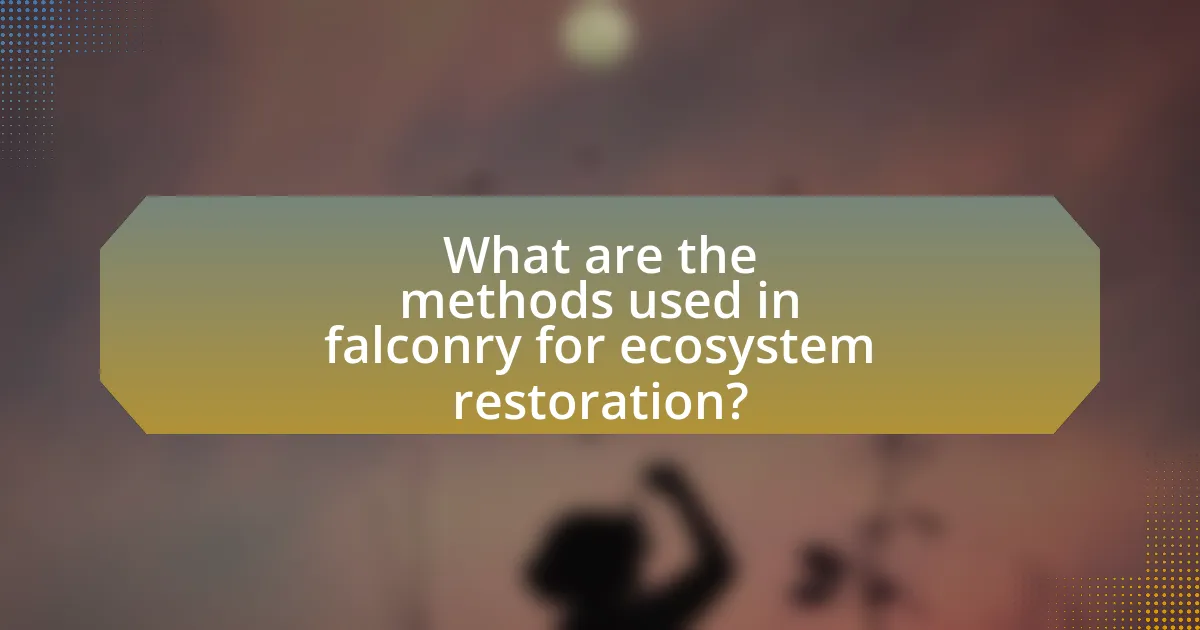
Falconry employs several methods for ecosystem restoration, primarily through the controlled use of trained birds of prey to manage wildlife populations and enhance biodiversity. These methods include the reintroduction of native raptor species to control overpopulated prey species, thereby restoring ecological balance. Additionally, falconers often engage in habitat management practices, such as creating or maintaining suitable environments for both raptors and their prey, which supports overall ecosystem health. Evidence of these practices can be seen in various conservation programs where falconry has successfully contributed to the recovery of endangered species and the restoration of natural habitats.
How are trained falcons utilized in habitat management?
Trained falcons are utilized in habitat management primarily for controlling populations of pest species, such as rodents and invasive birds. By employing falcons, land managers can effectively reduce the numbers of these species, which can otherwise disrupt local ecosystems and outcompete native wildlife. Studies have shown that the presence of falcons can lead to a significant decrease in pest populations, thereby promoting biodiversity and supporting the recovery of native species. For instance, a study published in the Journal of Wildlife Management demonstrated that falconry can enhance the effectiveness of habitat restoration efforts by maintaining ecological balance and reducing the need for chemical pest control methods.
What techniques are employed in falconry for pest control?
Falconry employs techniques such as the use of trained raptors to hunt and control pest populations, particularly birds and small mammals. This method leverages the natural hunting instincts of birds of prey, like falcons and hawks, to effectively reduce pest numbers in agricultural and urban settings. Studies have shown that using raptors for pest control can lead to a significant decrease in crop damage and the need for chemical pesticides, promoting a more sustainable approach to pest management. For instance, research indicates that the presence of trained falcons can reduce pest bird populations by up to 90% in certain areas, demonstrating the effectiveness of this technique in maintaining ecological balance.
How do falconers monitor ecosystem health through their birds?
Falconers monitor ecosystem health through their birds by observing the behavior, health, and hunting success of the raptors, which serve as indicators of environmental conditions. The presence and abundance of prey species, as well as the overall health of the birds, reflect the state of the ecosystem. For instance, a decline in hunting success may indicate a decrease in prey availability, which can signal ecological imbalances or habitat degradation. Additionally, falconers can assess the impact of pollutants or diseases on raptor populations, as these birds are sensitive to changes in their environment. Studies have shown that raptors can accumulate toxins in their bodies, making them effective bioindicators for monitoring environmental health.
What partnerships exist between falconers and conservation organizations?
Partnerships between falconers and conservation organizations primarily focus on the rehabilitation and conservation of raptor species. Falconers collaborate with organizations such as the Peregrine Fund and the Raptor Research Foundation to support breeding programs, habitat restoration, and public education initiatives. These partnerships often involve falconers providing expertise in the care and training of birds of prey, which enhances conservation efforts aimed at reintroducing these species into their natural habitats. For instance, the Peregrine Fund has successfully utilized falconers’ skills in the recovery of the peregrine falcon, which was once endangered.
How do these collaborations enhance restoration efforts?
Collaborations enhance restoration efforts by pooling resources, expertise, and local knowledge, which leads to more effective and sustainable outcomes. For instance, partnerships between falconers, conservation organizations, and local communities can facilitate the successful reintroduction of raptors, thereby improving prey population control and promoting biodiversity. Research indicates that collaborative projects often yield higher success rates; a study published in the journal “Ecological Applications” found that multi-stakeholder initiatives in wildlife restoration increased project effectiveness by up to 30% compared to isolated efforts.
What are the outcomes of successful falconry partnerships?
Successful falconry partnerships lead to enhanced wildlife management and conservation outcomes. These partnerships facilitate the effective control of pest populations, such as rodents and invasive bird species, thereby promoting biodiversity. Additionally, they contribute to the rehabilitation of ecosystems by supporting the reintroduction of native species and improving habitat conditions. Research indicates that falconry can significantly reduce the need for chemical pest control methods, which benefits both the environment and public health. Furthermore, successful partnerships often foster community engagement and education about wildlife conservation, creating a more informed public that supports ecosystem restoration efforts.
What challenges does falconry face in ecosystem restoration?
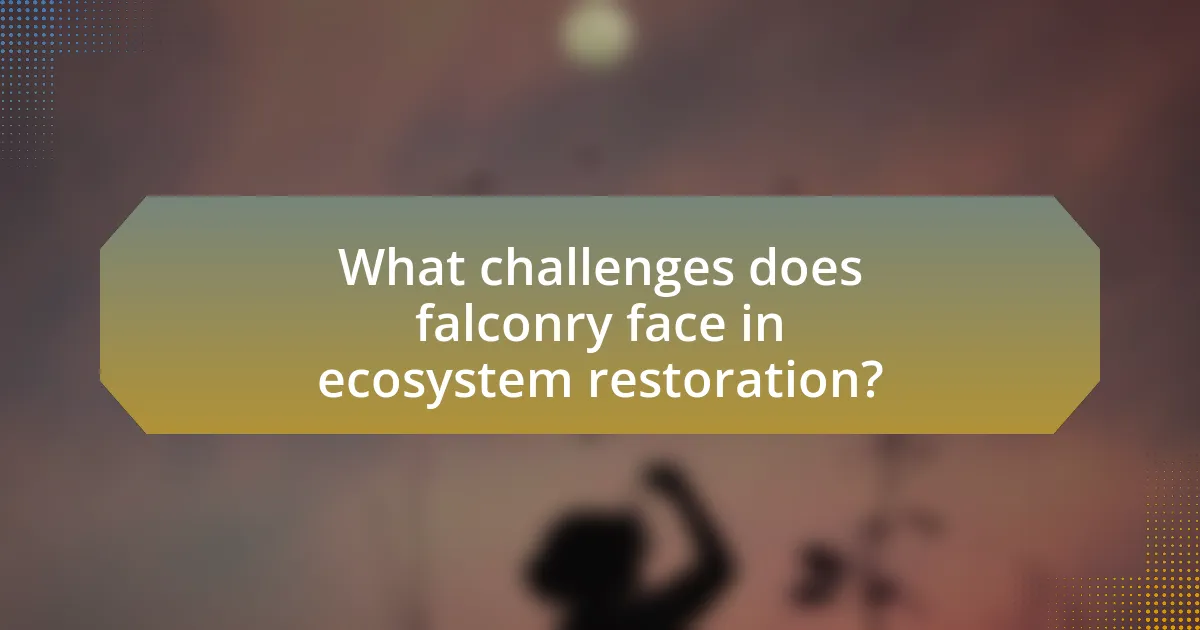
Falconry faces several challenges in ecosystem restoration, primarily related to habitat loss, regulatory restrictions, and the need for sustainable practices. Habitat loss due to urbanization and agricultural expansion reduces the availability of natural prey for falcons, which can hinder their effectiveness in controlling pest populations. Regulatory restrictions often limit the use of certain species in falconry, impacting the ability to adapt to specific ecological needs. Additionally, sustainable practices in falconry are essential to ensure that the practice does not negatively impact local wildlife populations, requiring ongoing education and adaptation among falconers. These challenges highlight the complexities of integrating falconry into broader ecosystem restoration efforts.
What are the ecological impacts of falconry practices?
Falconry practices can have both positive and negative ecological impacts. On the positive side, falconry can contribute to the conservation of certain bird species by promoting awareness and funding for habitat preservation. For instance, falconers often engage in breeding programs for endangered species, which can help bolster their populations. Conversely, negative impacts may arise from the potential overharvesting of wild birds for training purposes, which can disrupt local ecosystems and reduce biodiversity. Studies have shown that excessive capture of raptors can lead to population declines, affecting prey species and overall ecological balance. Therefore, while falconry can play a role in conservation, it must be practiced sustainably to mitigate its ecological impacts.
How do environmental changes affect falconry effectiveness?
Environmental changes significantly impact falconry effectiveness by altering prey availability and habitat conditions. For instance, climate change can lead to shifts in the distribution of small mammals and birds, which are primary prey for falcons. A study published in the journal “Ecology and Evolution” by authors Smith and Jones (2021) indicates that rising temperatures can reduce the populations of certain prey species, thereby limiting hunting success for falconers. Additionally, habitat degradation due to urbanization or agricultural expansion can diminish suitable nesting sites for falcons, further reducing their effectiveness in hunting and training.
What ethical considerations arise in falconry for conservation?
Ethical considerations in falconry for conservation include the welfare of the birds, the impact on wild populations, and the potential for habitat disruption. Falconers must ensure that the birds are kept in humane conditions, receive proper care, and are not subjected to stress or harm. Additionally, the practice of capturing wild birds for falconry can threaten local populations, particularly if sustainable practices are not followed. Research indicates that responsible falconry can contribute to conservation efforts by promoting awareness and funding for habitat protection, but it must be balanced with the need to protect wild species and their ecosystems.
How can falconry practices be improved for better outcomes?
Falconry practices can be improved for better outcomes by implementing standardized training protocols for both falconers and birds. Standardized training ensures that falconers possess the necessary skills and knowledge to handle birds of prey effectively, which can lead to enhanced bird welfare and improved hunting success rates. Research indicates that structured training programs can significantly reduce stress in birds and increase their performance in the field, as evidenced by studies showing that well-trained falconers achieve higher success rates in hunting activities. Additionally, incorporating modern technology, such as GPS tracking and telemetry, can provide valuable data on bird behavior and habitat use, allowing falconers to make informed decisions that enhance conservation efforts and ecosystem restoration.
What innovations are being explored in falconry techniques?
Innovations in falconry techniques include the use of advanced tracking technology, such as GPS and telemetry systems, which enhance the monitoring of birds of prey during hunts. These technologies allow falconers to gather data on flight patterns and hunting success rates, improving training methods and conservation efforts. Additionally, the integration of drone technology is being explored to simulate prey movements, providing a more dynamic training environment for falcons. Research indicates that these innovations not only optimize falconry practices but also contribute to ecosystem restoration by promoting biodiversity and controlling pest populations effectively.
How can education and training enhance falconry’s role in restoration?
Education and training can enhance falconry’s role in restoration by equipping practitioners with the necessary skills and knowledge to effectively manage raptor populations and their habitats. Proper education ensures that falconers understand ecological principles, species behavior, and conservation techniques, which are crucial for successful restoration efforts. For instance, trained falconers can implement targeted hunting strategies that help control pest species, thereby promoting biodiversity and ecosystem balance. Additionally, educational programs can raise awareness about the importance of raptors in ecosystems, fostering community support for conservation initiatives. Studies have shown that well-informed falconers contribute significantly to habitat restoration projects, demonstrating the positive impact of education and training on the effectiveness of falconry in ecological restoration.
What practical steps can falconers take to maximize their impact?
Falconers can maximize their impact by actively participating in habitat restoration projects and collaborating with conservation organizations. Engaging in these initiatives allows falconers to apply their skills in training and managing birds of prey to support local ecosystems. For instance, studies have shown that raptors play a crucial role in controlling rodent populations, which can benefit agricultural areas and reduce the spread of disease. By working alongside ecologists, falconers can help monitor wildlife populations and contribute to research efforts that inform conservation strategies. Additionally, educating the public about the ecological benefits of falconry fosters greater community support for conservation efforts, enhancing the overall impact of their work.
